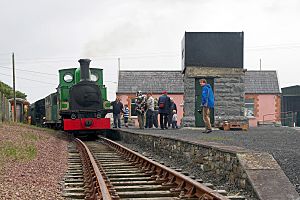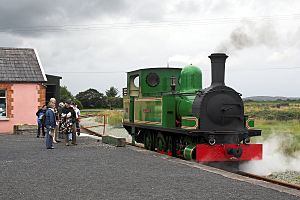West Clare Railway facts for kids
Quick facts for kids West Clare Railway |
|
|---|---|

Moyasta Junction with water tower
|
|
| Locale | County Clare, Ireland |
| Coordinates | 52°40′5.09″N 9°32′9.97″W / 52.6680806°N 9.5361028°W |
| Commercial operations | |
| Original gauge | 3 ft (914 mm) |
| Preserved operations | |
| Length | 43.4 km (27.0 mi) |
| Preserved gauge | 3 ft (914 mm) |
| Commercial history | |
| Opened | 1887 |
| Closed | 1961 |
The West Clare Railway (WCR) was a special train line in County Clare, Ireland. It ran from 1887 to 1961. This railway was a narrow-gauge line, meaning its tracks were closer together than regular tracks. It was only 3 ft (914 mm) wide!
The railway started in Ennis and went along the West Clare coast. It had two end stops: Kilrush and Kilkee. The tracks split at a place called Moyasta Junction. The West Clare Railway was the very last narrow-gauge passenger train system in Ireland. It connected to the main train lines in Ennis. Today, you can still find a station in Ennis for buses and trains to other cities.
A group of people who love trains now runs a railway museum at Moyasta Junction station. They successfully reopened a part of the railway. You can ride on it again! At first, they used diesel trains in the 1990s. Then, in 2009, they brought back steam trains.
Contents
Building the West Clare Railway
After the Irish Potato Famine, local businesses in Ireland started to grow again. The British Government decided that better railways were needed. This would help the West of Ireland recover. The West Clare Railway and the South Clare Railway were built by different companies. But the West Clare Railway ended up running the whole line. The two lines met at Milltown Malbay. Soon, the entire line became known as the West Clare Railway.
The First Section: Ennis to Milltown Malbay
The first part of the West Clare Railway was 43.4 km long (27.0 mi). It ran between Ennis and Milltown Malbay. Work on this section began in November 1884. A famous politician, Charles Stewart Parnell, officially started the building on January 26, 1885.
In February 1887, another railway company tried to stop the West Clare Railway. They claimed the land where the West Clare Railway was building. After some talks, the West Clare Railway agreed to pay rent for using the land. The line officially opened on July 2, 1887.
Extending the Line: South Clare Railway
The South Clare Railway built the next part of the line. This extension went from Milltown Malbay to Kilrush and Kilrush docks. It also had a branch line that went to Kilkee from Moyasta. This part of the railway was suggested in 1889. Building started in October 1890 and it opened on May 11, 1892.
The West Clare Railway operated this new extension. At first, trains were often late and the service wasn't great. But things got better over time. One reason for delays was a rule that said passenger and goods trains had to run separately.
Train Journeys and Famous Songs
The West Clare Railway became famous because of a song. Percy French wrote "Are Ye Right There Michael" in 1902. The song made fun of how often the trains were late and how bumpy the tracks were. Some people thought the song was funny, but others worried it made it harder to keep the railway open.
Percy French wrote the song after he sued the railway company. A late train made him miss a show he was supposed to perform. He won his case and was given money. The company tried to appeal the decision. But Percy French was late for the court hearing too! He told the judge, "I took the West Clare Railway here, your honour. " The company lost their appeal.
Many stories grew around this event. Percy French was four and a half hours late for his show in Kilkee on August 10, 1896. He had started his trip in Dublin that morning. His show started late, and fewer people came to watch. He won his case in January 1897 and was awarded £10. The newspaper headline was "An Hour With Percy French 'free of charge'". The railway company often fought lawsuits, which was not a good plan for them.
Joining Bigger Companies
In 1925, the West Clare Railway joined a bigger company called the Great Southern Railways. Then, in 1945, the Great Southern Railways was taken over by Córas Iompair Éireann (CIÉ), which is Ireland's national transport company.
Around that time, people looked into replacing the railway with road services. Local people wanted the railway to be changed to the standard Irish gauge (5 ft 3 in (1,600 mm) wide). But CIÉ said it would cost too much money to do this.
Steam Locomotives (Old Trains)
The West Clare Railway used 18 different steam locomotives. Sometimes, when an old train was removed, its number was given to a new train. So, some numbers appear more than once in the list below. Each row is a different train.
| Number | Name | Class | Class (GSR) | Wheel arrangement |
Built | Notes |
|---|---|---|---|---|---|---|
| 1 | Original | 0-6-0T | 1886 Bagnall | These first four trains were too light; they were removed by 1915. | ||
| 2 | Original | 0-6-0T | 1886 Bagnall | Removed by 1900. | ||
| 3 | Clifden | Original | 0-6-0T | 1887 Bagnall | Removed by 1915. | |
| 4 | Besborough | Original | 0-6-0T | 1887 Bagnall | Removed by 1901. | |
| 5 | Slieve Callan | IN1 | 5C | 0-6-2T | 1892 Dübs & Co | This train is saved and has been running on the WCR since 2009. |
| 6 | Saint Senan | IN1 | 5C | 0-6-2T | 1892 Dübs & Co | Just like train number 5. |
| 7 | Lady Inchiquin | IN1 | 5C | 0-6-2T | 1892 Dübs & Co | Just like train number 5. |
| 8 | Lisdoonvarna | PN1 | 2C | 2-6-2T | Dübs & Co | |
| 9 | Fergus | PN1 | 2C | 2-6-2T | T Green | |
| 2 | Ennis | PN1 | 2C | 2-6-2T | T Green | |
| 4 | Liscannor | PN1 | 2C | 2-6-2T | T Green | |
| 10 | Lahinch | BN1 | 10C | 4-6-0T | Kerr, Stuart & Co | |
| 11 | Kilkee | BN2 | 11C | 4-6-0T | Bagnall | |
| 1 | Kilrush | BN3 | 1C | 4-6-0T | Hunslet | |
| 3 | Ennistymon | BN4 | 3C | 4-6-0T | Hunslet | |
| 7 | Malbay | BN4 | 3C | 4-6-0T | Hunslet | |
| 6 | 2-6-0T | Hunslet | Bought used, just before the railway closed. | |||
| 8 | 2-6-0T | Hunslet | Bought used, just before the railway closed. |
Diesel Locomotives (Newer Trains)
In the early 1950s, CIÉ started using diesel trains on the West Clare Railway. This was quite new for the time! They used four new diesel railcars for passengers. These were built by Walker Brothers in England. They also got three diesel locomotives from the same company.
Using diesel trains helped to lower the costs of running the railway. However, this new investment didn't last long. The railway closed soon after.
| Number | Type | Built | Notes |
|---|---|---|---|
| Diesel railcar | Walker Brothers | ||
| Diesel railcar | Walker Brothers | ||
| Diesel railcar | Walker Brothers | ||
| Diesel railcar | Walker Brothers | ||
| F501 | 107 bhp diesel locomotive | 1955 Walker Brothers | |
| F502 | 107 bhp diesel locomotive | 1955 Walker Brothers | |
| F503 | 107 bhp diesel locomotive | 1955 Walker Brothers |
The Railway Closes Down
Even with the new diesel trains, the West Clare Railway closed. Passenger services switched to diesel in 1952, and freight (goods) services in 1953. But the railway was still losing money.
On September 27, 1960, CIÉ announced the railway would close on February 1, 1961. They said the West Clare Railway was losing £23,000 each year. This is like losing over €1.2 million today! The line officially closed on January 31, 1961. CIÉ started taking apart the tracks the very next day.
When it closed, the West Clare Railway was the last narrow-gauge railway in Ireland that carried passengers. Some other narrow-gauge lines still run today, but they are mainly for moving peat (a type of fuel).
Saving and Reopening the Railway
In the mid-1990s, a group of people started working to save part of the railway. They managed to get Moyasta station and about 5 km (3.1 mi) of the old track. They started passenger services again! They used two new steel coaches, which are like train cars, built for visitors. A small but strong diesel train, originally used for building the Channel Tunnel, pulled the coaches.
On July 5, 2009, one of the West Clare Railway's original steam trains, No 5 Slieve Callan, came back home. It had been restored in England. This train used to be on display at the Ennis train station. On July 14, it was steamed up for the first time. This was a big moment, as it was the first time a steam train had run on the West Clare Railway in over 57 years!
The railway has also bought other diesel trains. Most of these came from Bord na Móna, an Irish company that works with peat. These trains are slowly being fixed up and put back into service.
Trains You Can See Today
Besides the steam train Slieve Callan, the railway has 12 diesel engines. Two of these are currently working. The others are waiting to be fixed. The working ones include a small shunting engine from the Channel Tunnel and one from Bord na Móna.
There are also two passenger coaches that are used for rides. Plus, there are other vehicles for maintaining the tracks, like a tank wagon and flat trucks.
- Irish Standard Gauge Trains
In 2008, the railway got an old Irish Rail diesel train, No.015. This train is the standard Irish gauge (5 ft 3 in (1,600 mm) wide). It's on display for visitors to see.
There are also three standard gauge passenger coaches on site. One is used as a welcome center and cafe for visitors. Another is a lecture room for groups.
The standard gauge coaches include:
- Great Southern Railways carriage No.1325.
- Iarnród Éireann mkIIa carriages Nos.4108, 4110 and 4402 (a restaurant car).
A group called the Irish Traction Group also stores some of their mainline diesel trains here. These are either stored or on display. They include:
- 001 class No. A3R
- 121 class locomotive No. 124
- 141 class locomotive No. 152
- 181 class locomotive No. 190
See also
 In Spanish: West Clare Railway para niños
In Spanish: West Clare Railway para niños


